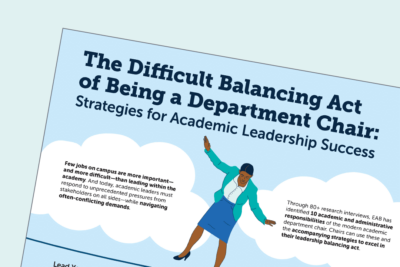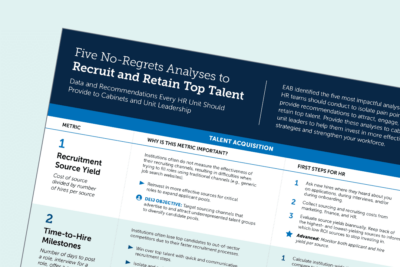Employee Recruitment and Retention Resource Center
Amid record-setting employee turnover and disengagement, higher ed leadership teams have little choice but to rethink how they recruit and retain talent. Increased competition with out-of-sector employers has elevated this priority across leadership teams. Prioritizing recruitment and retention strategies will only become more critical as the workforce diversifies and shrinks, with a predicted six million person deficit between labor supply and demand by 2028.
Yet, most institutions have already fallen behind on today’s table stakes to compete. EAB survey data show that many effective tactics used in other industries to support recruitment and retention efforts are still “progressive” in higher ed. Unsurprisingly, then, most institutions are still struggling to build competitive applicant pools and hold on to top performers.
Below are five key areas campus leadership teams must invest in to bolster employee recruitment and retention―and the top EAB tools and resources to expedite progress and ease implementation.
-
Recruiting and Hiring Strategy
-
Employee Engagement and Effectiveness
-
Career and Leadership Development
-
Flexible Work for Hybrid and Remote Employees
-
Inclusive Recruitment and Retention Practices
Recruiting and Hiring Strategy
Challenge: Outdated and cumbersome hiring practices can immediately deter talented applicants and reduce institutions’ competitiveness with out-of-sector employers.
Solution: Improve the size and quality of candidate pools by removing unnecessary barriers to entry, articulating your employee value proposition, and streamlining your application and interviewing processes.
Access the tools and resources
Many campus leaders rely on institutional brand to attract applicants and deploy a lengthy, often burdensome hiring and interview process before making offers. Higher ed job descriptions also tend to include onerous education and/or experience requirements, even for entry level roles. Together, these practices can result in weak or shallow candidate pools and even deter otherwise interested candidates from accepting an offer. This is especially true for younger generations of the workforce, which expect a more seamless and customized application and interviewing process.
Imperatives for campus leadership teams:
- Maximize your pipeline for talent by implementing solutions to increase pre-awareness through active recruiting and improve application processes.
- Revise job descriptions to increase accessibility, reduce barriers to entry, and promote your employee value proposition.
- Update your institution’s employment website to improve functionality, highlight inclusion, and showcase the value and benefits of working there.
- Use behavioral-based interviewing to broaden and diversify your applicant pool by identifying candidates who have transferrable skills and prior experiences.
Employee Engagement and Effectiveness
Challenge: Employee disengagement can cause decreased workforce efficiency and increased turnover, which in turn diminishes service quality and campus culture.
Solution: Set employees up for success and keep them engaged and productive across their careers through intentional onboarding, management, and feedback processes.
Access the tools and resources
Most institutions have underinvested in employee onboarding and workplace culture improvements despite low morale and employee engagement. Moreover, many campus leaders have struggled to implement widespread, high-quality manager training and consistent performance review requirements and processes. Collectively, this often results in employees feeling underprepared, disengaged, and unsure about how their work contributes to the broader institutional mission and goals.
Imperatives for campus leadership teams:
- See our infographic for 105 different tactics to increase employee engagement.
- Transform the onboarding experience to create more engaging staff experiences and improve employee career trajectories at the institution.
- Provide managers with resources to better orient, educate, and onboard remote employees.
- Shift from annual performance reviews to a continuous feedback model to promote staff engagement, minimize required documentation, and improve feedback quality.
- Discover strategies to size and address the faculty burnout epidemic.
Career and Leadership Development
Challenge: Many high-performing employees are leaving higher ed for out-of-sector positions that offer better and faster career trajectories.
Solution: Provide structured career support and advancement opportunities to retain high-performing employees and bolster your leadership pipeline.
Access the tools and resources
While campus leaders often assume compensation is the top source of higher ed employee dissatisfaction, it is actually career advancement.
Yet, institutions provide limited professional development opportunities for employees to build leadership skills and advance their careers internally. When higher ed leaders fail to tap into the internal talent pipeline and utilize employees’ diverse skillsets, skilled employees seek external opportunities for advancement.
Imperatives for campus leadership teams:
- Increase internal talent mobility by eliminating structural barriers, defining latticed career pathways, and creating career development opportunities for employees.
- Build cabinet members’ capacity to lead their institutions amid crises and improve long-term strategic thinking.
- Embed mentoring programs into faculty professional development to ensure faculty across tenure ranks have support to advance their career.
- Identify high-potential employees and build customized development plans to prepare them for continued growth through succession planning.
-
37%
of staff agree that their development is invested in
-
29%
of staff agree that they have advancement opportunities
Flexible Work for Hybrid and Remote Employees
Challenge: Employees want flexible work options, but they are especially difficult to implement in campus environments that value in-person service interactions and have such diverse employee groups, roles, and requirements for on-campus work.
Solution: Navigate the rise in hybrid and remote work by creating clear, equitable policies that advance institutional goals and strengthen recruitment and retention strategies.
Access the tools and resources
With more employees seeking hybrid or remote work arrangements―and more out-of-sector employers offering them―higher ed must embrace flexible work options to compete for top talent.
Yet, campus leaders are struggling to implement a clear hybrid and/or remote work policy that aligns with institutional goals. Moreover, campus leaders are unsure about how to ensure equity across employees and maintain a strong campus culture in an increasingly hybrid work environment.
Imperatives for campus leadership teams:
- Garner campus buy-in for flexible work and staffing policies that improve applicant pools, decrease turnover, compete with out-of-sector employers, and reduce costs.
- Complete a remote work policy audit to diagnose strengths and/or weaknesses, learn about best practices, and receive concrete suggestions for policy improvements.
- Prepare managers to onboard remote employees so they can build their network and successfully navigate the institution.
- Adapt on-campus workstations to meet hybrid employees’ needs for administrative office space.
Inclusive Recruitment and Retention Practices
Challenge: Outdated institutional processes and policies perpetuate biased talent practices, contribute to an exclusive workplace culture, and hinder institutions from achieving faculty and staff diversity goals.
Solution: Advance cross-campus DEIJ goals through inclusive talent initiatives that attract and support diverse employees throughout their career.
Access the tools and resources
Many strategic plans include DEIJ initiatives to support staff and faculty. However, siloed support systems, structures, policies, and hiring practices often hinder efforts to attract and retain diverse employees. Barriers to entry prevent diverse applicants from applying and internal hiring practices fail to safeguard against biases. Once hired, inadequate initiatives to support diverse employees can result in stalled career advancement, disengagement, and turnover.
Imperatives for campus leadership teams:
- Implement candidate-centered, inclusive hiring practices to recruit diverse university staff.
- Identify and alleviate common caregiving pain points to help reduce employee stress and improve engagement.
- Expand talent pools and retain talented employees by addressing their most pressing basic needs around caregiving, housing, food, and transportation.
- Embed diversity and inclusion into faculty hiring practices at the department level to improve accountability, training for committees, and applicant evaluation.
- Support employees with disabilities from hiring to accommodations to performance management and career advancement.
- Assess critical metrics such as promotion and tenure, total credit hours taught, and research grants awarded to diagnose racial inequities amongst faculty.
- Design promotion and tenure, workload, and faculty committee policies to retain and support BIPOC faculty.
More Resources

The difficult balancing act of being a department chair

Succession Planning Toolkit
